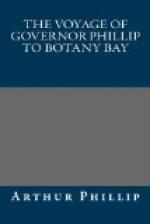At noon on the 28th, more islands were seen, bearing from north to north-west by west, three or four leagues distant, their latitude at that time was 8 deg. 02’ north, and 170 deg. 57’ east longitude. The weather being very hazy, with constant rain, they wore, and stood from the land; however, the afternoon proving tolerably clear, they again stood towards it, and by four o’clock were close in with the westernmost island. Two large canoes were lying on a sandy beach, but they did not perceive any inhabitants. At five o’clock they saw several more islands, bearing north north-east, five or six leagues distant. During the night, Captain Marshall stood under an easy sail, and at day-light the next morning land was seen a-head bearing north by east six leagues, and some land bearing east seventeen leagues distant. These islands, like all they had yet seen, were very low, and entirely covered with lofty trees; on sounding, they got no ground with an hundred fathoms of line. Their latitude at noon was 8 deg. 59’ north, and 170 deg. 24’ east longitude.
30 June 1788
At five in the afternoon, more islands were seen, bearing north, five leagues distant, but night coming on they wore and stood to the southward. In the forenoon of the 30th, they ran between two islands, about five leagues distant from each other, and surrounded by a number of breakers: by eleven o’clock they were entirely clear of all the land. Their observation at noon gave 9 deg. 34’ north latitude, and the longitude was 169 deg. 22’ east. These last islands were supposed by Captain Marshall to be those which Lord Anson discovered, and named Barbadoes Islands.
31 July 1788
Having now a clear navigation, they prosecuted their voyage without meeting with any thing worthy of notice till the 31st of July, when at six clock in the morning they saw the island of Saypan bearing west by south six leagues distant. Having light baffling winds, they did not get in with the land till the approach of evening, so that the night was spent in standing off and on. At day-light the next morning, Captain Marshall sent his boat on shore, with the chief mate and four seamen, to procure some refreshments, and look for anchorage. At two o’clock in the afternoon, the boats returned loaded with cocoa-nuts and cabbage, both, as the men reported, from the same tree, but they could find no place for a vessel to anchor in, the water being very deep close to the land, with a rocky bottom, and so heavy a surf that the boat did not land without great difficulty. Not meeting with a harbour at Sapan, the Captain determined to make the best of his way to Tinian, where he might come to anchor and get his sick people on shore, having no less than fifteen men laid up with the scurvy, and the rest of his crew were so weak that they could scarcely work the ship: the wind, however, was so variable, that they did not reach the south-west side of that island till afternoon on the 4th, when they anchored in twenty-five fathoms water, and soon afterwards the Charlotte came to anchor a small distance from the Scarborough.




